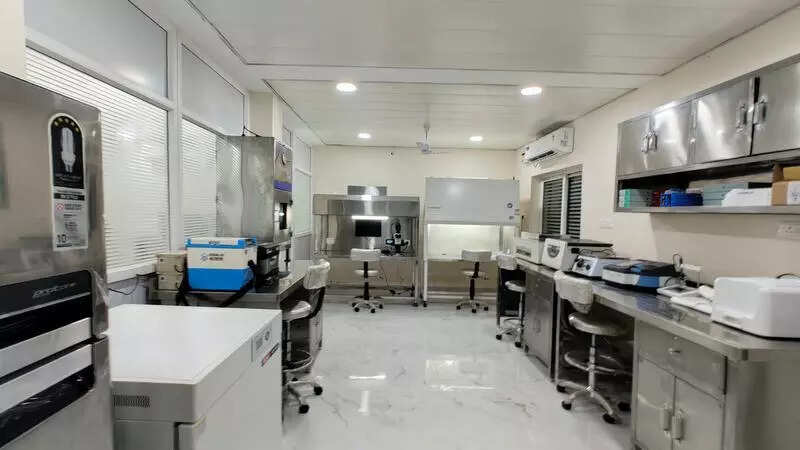Nandankanan gets bio-banking facility to store genetic materials | Bhubaneswar News

Bhubaneswar: Nandankanan Zoological Park has set up the country’s first comprehensive bio-banking facility to store genetic materials of animals such as semen, tissues, oocytes, and cells for future use in breeding and restoring animals of extinct species. Storing of biological materials will help the zoo in using in-vitro fertilisation (IVF) techniques for breeding.
Zoo officials said the bio-banking facility has 18 pieces of equipment, including an inverted microscope, stereo zoom microscope, automatic cryogenic tube and straw sealing machine, vitrification unit, IVF workstation, laminar airflow, portable refrigerators, CO2 incubator, water bath, spectrophotometer, and slide warming table.
“Bio-banking involves the collection, processing, and long-term storage of biological samples such as gametes, embryos, tissues, and DNA under cryogenic conditions. In India, Nandankanan is the only zoo to have a full-fledged dedicated biological samples preserving centre, although Darjeeling Zoo has done some work towards sample storing,” said zoo deputy director Sanath Kumar.
He added that by serving as a repository of genetic material, biobanks help mitigate the risks of biodiversity loss, aid in assisted reproductive technologies, and support research in genetics and disease management, contributing to global conservation efforts. Bio-banking will support ecological and evolutionary research in the zoo. “It will ensure that future generations have the opportunity to restore and preserve species that face extinction today,” Kumar said.
Currently, the zoo has over 4,000 inmates of 162 species. It has more than 200 enclosures for animals, including birds and reptiles. The zoo now has 15 normal colour tigers, five white, and four melanistic (black stripe) tigers. “We in the zoo are running species recovery and captive breeding programmes. The bio-banking has a lot of potential to augment captive breeding as stored gametes and embryos can be used in captive breeding programmes to maintain genetic diversity without the need to move live animals, thus reducing stress and risks,” the senior zoo functionary added.
Besides IVF, bio-banking can facilitate embryo transfer and can be used to breed species with minimal intervention in their natural habitats. For critically endangered species, bio-banking can act as a genetic “insurance policy.” “Even if a species becomes extinct in the wild, their genetic material can be used to attempt future revival or restoration,” officials said.
Zoo officials said the bio-banking facility has 18 pieces of equipment, including an inverted microscope, stereo zoom microscope, automatic cryogenic tube and straw sealing machine, vitrification unit, IVF workstation, laminar airflow, portable refrigerators, CO2 incubator, water bath, spectrophotometer, and slide warming table.
“Bio-banking involves the collection, processing, and long-term storage of biological samples such as gametes, embryos, tissues, and DNA under cryogenic conditions. In India, Nandankanan is the only zoo to have a full-fledged dedicated biological samples preserving centre, although Darjeeling Zoo has done some work towards sample storing,” said zoo deputy director Sanath Kumar.
He added that by serving as a repository of genetic material, biobanks help mitigate the risks of biodiversity loss, aid in assisted reproductive technologies, and support research in genetics and disease management, contributing to global conservation efforts. Bio-banking will support ecological and evolutionary research in the zoo. “It will ensure that future generations have the opportunity to restore and preserve species that face extinction today,” Kumar said.
Currently, the zoo has over 4,000 inmates of 162 species. It has more than 200 enclosures for animals, including birds and reptiles. The zoo now has 15 normal colour tigers, five white, and four melanistic (black stripe) tigers. “We in the zoo are running species recovery and captive breeding programmes. The bio-banking has a lot of potential to augment captive breeding as stored gametes and embryos can be used in captive breeding programmes to maintain genetic diversity without the need to move live animals, thus reducing stress and risks,” the senior zoo functionary added.
Besides IVF, bio-banking can facilitate embryo transfer and can be used to breed species with minimal intervention in their natural habitats. For critically endangered species, bio-banking can act as a genetic “insurance policy.” “Even if a species becomes extinct in the wild, their genetic material can be used to attempt future revival or restoration,” officials said.
















